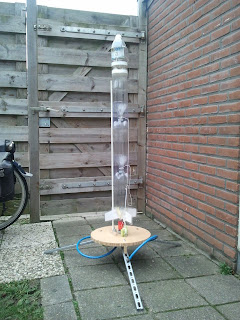The new launcher should contain the gardena quick release and a launch rod to guide the rocket. I wanted to make it a tripod so it would be stable on uneven surfaces. Beneath is an image I made with Blender (a free open source 3D creation program) just to see what it would look like.
I had some leftover plywood which would function as a base for the launcher. For the launch rod I used 2 pieces of 10mm glass fibre rod fitted over a piece of 8mm carbon fibre rod, this makes the rod easy to transport because it can be divided into two parts. The legs of 50cm length where sawed from a mounting rail and are mounted on the base with bolts and nuts, so they can easily be removed for transport. The gardena quick release is pulled down by a pair of springs, during pressurization the quick release is held in the locked position by a piece of wood. At launch this is pulled out, the springs pull the collar down and the rocket is released.
Ready to launch some rockets!.... or isn't it...






